Junglefowl
The term "pecking order" comes from junglefowls' hierarchies among both sexes
Advertisement
Junglefowl Scientific Classification
Read our Complete Guide to Classification of Animals.
Junglefowl Conservation Status
Junglefowl Facts
- Prey
- worms, slugs, insects, mice, small lizards, and frogs
- Fun Fact
- The term "pecking order" comes from junglefowls' hierarchies among both sexes
- Estimated Population Size
- Unknown
- Biggest Threat
- Crossbreeding with domestic chickens
- Most Distinctive Feature
- Bright colors, red crest in males
- Other Name(s)
- Wild chicken, bankiva, bankiva fowl
- Wingspan
- Male 26-32in, female 14-25in
- Incubation Period
- 18-26 days
- Habitat
- Field edges, forests, scrubland, mountains, islands
- Predators
- Birds of prey, land-dwelling carnivorous animals
- Diet
- Omnivore
- Type
- Phasanid, bird
- Common Name
- Junglefowl
- Number Of Species
- 4
- Location
- South Asia, Southeast Asia
- Nesting Location
- Underbrush
- Age of Molting
- 1 year
View all of the Junglefowl images!
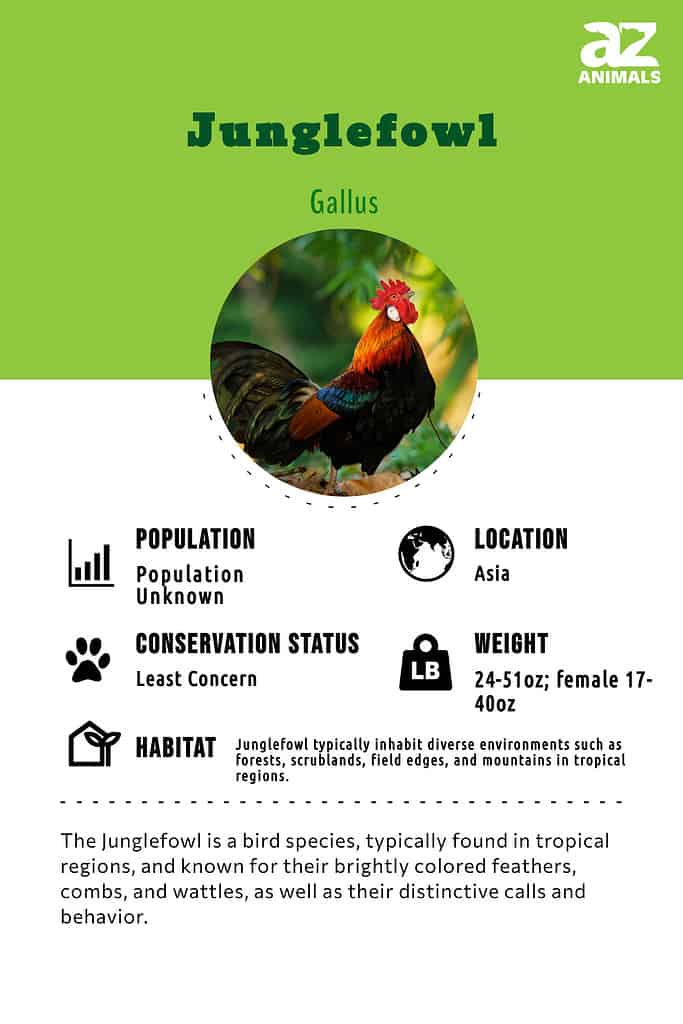
The junglefowl is the original chicken.
The ancestor of the domesticated chicken is the red junglefowl, which is from South Asia and Southeast Asia. However, it has influence from the grey, green, and Sri Lankan species as well. The chicken was domesticated about 8,000 years ago.
The junglefowl is used for meat, eggs, and feathers as much as domestic chickens, and often crossbreeds with them.
4 Amazing Junglefowl Facts!

The Sri Lankan junglefowl is the designated national bird of Sri Lanka.
©Martin Pelanek/Shutterstock.com
- The national bird of Sri Lanka is the Sri Lankan junglefowl.
- The domesticated chicken is the most widely domesticated bird on earth.
- Red jungle fowl used to be called Bankiva or Bankiva Fowl.
- Chickens are classed as red junglefowl, although the term refers to the wild subspecies.
Where To Find Junglefowl

Junglefowl are typically found in tropical regions and inhabit various environments such as islands, forests, scrublands, mountainous areas, and the edges of fields.
©Agami Photo Agency/Shutterstock.com
Junglefowl lives in tropical climates. Their habitats are islands, forests, scrubland, field edges, and mountains. They prefer natural and man-made disturbed areas and live alongside humans, especially in agricultural areas. Forests, trees, and thickets serve as their shelter.
You can find easily hens during the laying season, which is spring and summer because they lay an egg every day. Spring and summer are also breeding seasons, so you can also easily find territorial roosters during that time in open scrub and forest floors.
Nests
Junglefowl hens create nests in dense undergrowth or underbrush. There, they make a shallow depression in the ground and line it with feathers, grass, leaves, and sticks. However, if they find man-made coops with basket nests, they will use those as well.
Evolution and Origins
Around 4-6 million years ago, the junglefowl evolved from a common ancestor, and despite their Asian origin, there have been discoveries of junglefowl bone remnants in areas of Chile dating back to 1321-1407 CE, which suggests the possibility of Polynesian migration through the Pacific Ocean.
The modern classification of chickens (Gallus gallus domesticus) acknowledges that their main ancestor is the Red Junglefowl, which was domesticated in Southeast Asia and Oceana approximately 7,000-10,000 years ago.
Research conducted in 2020 on the genomes of 863 chickens revealed that the jungle fowl subspecies Gallus gallus spaedicus served as the predecessor of present-day chickens, and due to a higher level of DNA shared between the two, it was concluded that the domestication of chickens took place in Southeast Asia.
Scientific Name
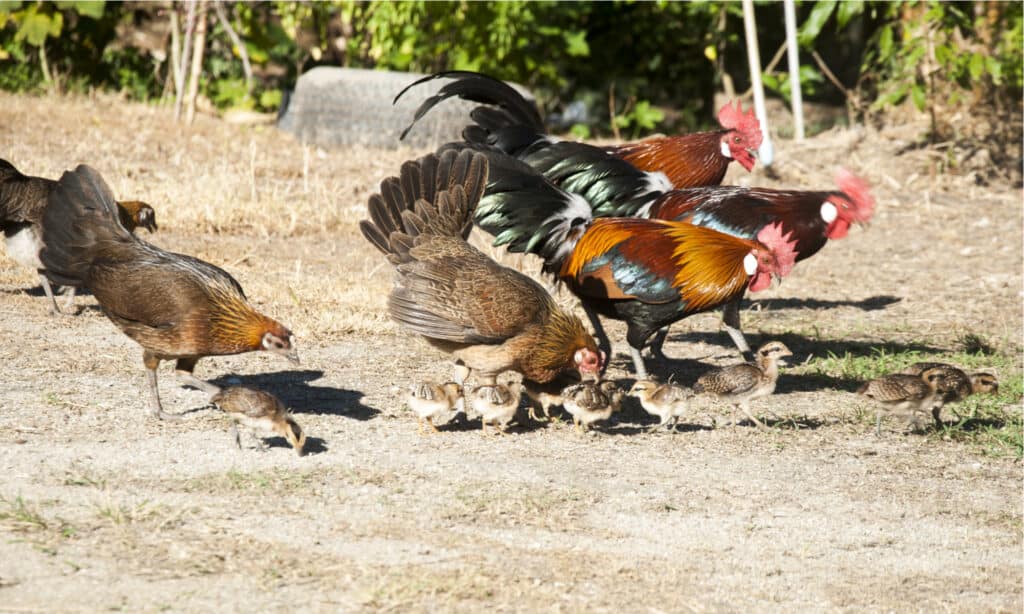
The junglefowl is categorized under the avian class, Aves, and belongs to the order Galliformes, which comprises chicken-like birds such as chickens, quails, turkeys, and other ground-dwelling birds that are heavy-bodied, also known as landfowl.
©dooguzi/Shutterstock.com
The junglefowl belongs to the class Aves (birds). Its order is Galliformes (“chicken-like”), which includes chickens as well as quails, turkeys, and other heavy-bodied ground-dwelling birds or landfowl.
Its family is Phasianidae (pheasant family of semi-flightless, gallinaceous game birds) which includes pheasants, partridges, peafowl, Old World quail, turkeys, junglefowl, and chickens.
Phasianidae has 54 genera and 184 species. Gallus is the junglefowl’s genus and means “rooster.”
There are four wild species and one domestic subspecies, each with a different geographic range:
- Red junglefowl (G. gallus): India, Pakistan, Indochina, Malaysia, Singapore, Philippines, and Indonesia
- Grey junglefowl (G. sonneratii), also called Sonnerat’s junglefowl: Indian Peninsula, Gujarat, Madhya Pradesh, south Rajasthan, and Pakistani Punjab
- Green junglefowl (G. varius), also called forktail, Javan, or green Javanese junglefowl: Indonesia, Java, Bali, Flores, Lombok, Komodo, Rinca, and small islands connecting Java with Flores
- Sri Lankan junglefowl (G. lafayettii), also called Ceylon or Lafayette’s junglefowl: Sri Lanka
- Domesticated chicken (G. gallus domesticus): Several countries in both the northern and southern hemispheres, especially China, followed by the United States and the U.K.
Genetically, the grey and green junglefowl are most closely related to the Sri Lankan junglefowl. The green junglefowl is less closely related to the red junglefowl.
Appearance
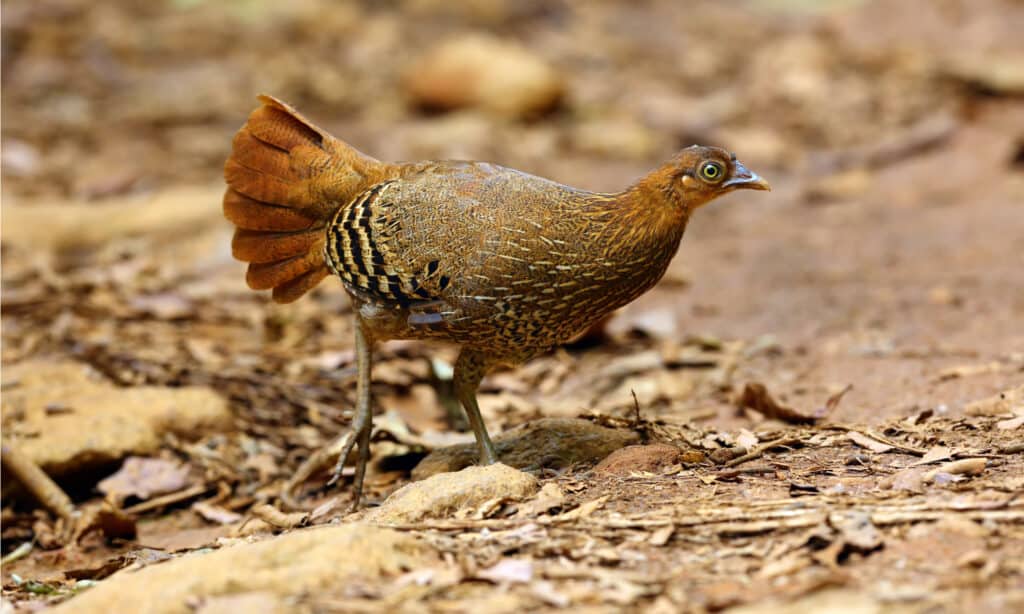
The junglefowl’s physical characteristics can vary depending on the particular subspecies.
©Karel Bartik/Shutterstock.com
The appearance of the junglefowl depends on the subspecies. The male red junglefowl has bright red, orange, gold, brown, grey, white, olive, and metallic green feathers. His 14 tail feathers look black but in light reveal to be blue, purple, and green.
His neck and back have golden feathers. He has a red comb and a wattle. He measures an average of 3.25 lbs (24-51oz) and 28 inches (26-30in) in total length. His tail can be up to 11 inches long and his wingspan is 26-32in long.
The female’s plumage has camouflage colors of various shades of brown and other earth tones. She measures an average of 2.25 lbs (17-37oz) in weight, 17-18in length, and 14-25in wingspan. In June, molting changes the male’s plumage to an eclipse pattern that lasts through October, which includes a black feather in the middle of his back and red-orange feathers around the body.
Similar in appearance to the red junglefowl, the male Sri Lankan junglefowl has orange-red body plumage and dark purple and blue to black wings and tail. He has a golden neck and back feathers, bare red skin, and a red wattle with a yellow center. He is 26-28 in length and weighs 1.74–2.51 lbs. The female is 14in long and weighs 1.124–1.422 lbs.
The grey junglefowl has a grey base color with black, ochre, and white spots in a fine pattern. His neck feathers are dark and end in yellow, which makes good artificial flies. His red wattle and comb are paler than in the red junglefowl. He has long, crescent-shaped tail feathers, and his legs are red and have spurs. eclipse plumage neck feathers that come from molting during or after the breeding season in the summer, like the red junglefowl. The female has yellow legs without spurs.
The green junglefowl resembles both the red and Sri Lankan junglefowl in physical appearance. Like the red, he has a black breast and sides and like the Sri Lankan, he has areas of bare facial skin that contrast against the red. His wattle is pale purple or red with an icy blue center.
His wattle is pale purple or red with blue on the edges and yellow near the throat. Below the ears is an area of electric yellow skin. The female is brown with rare green feathers and no comb.
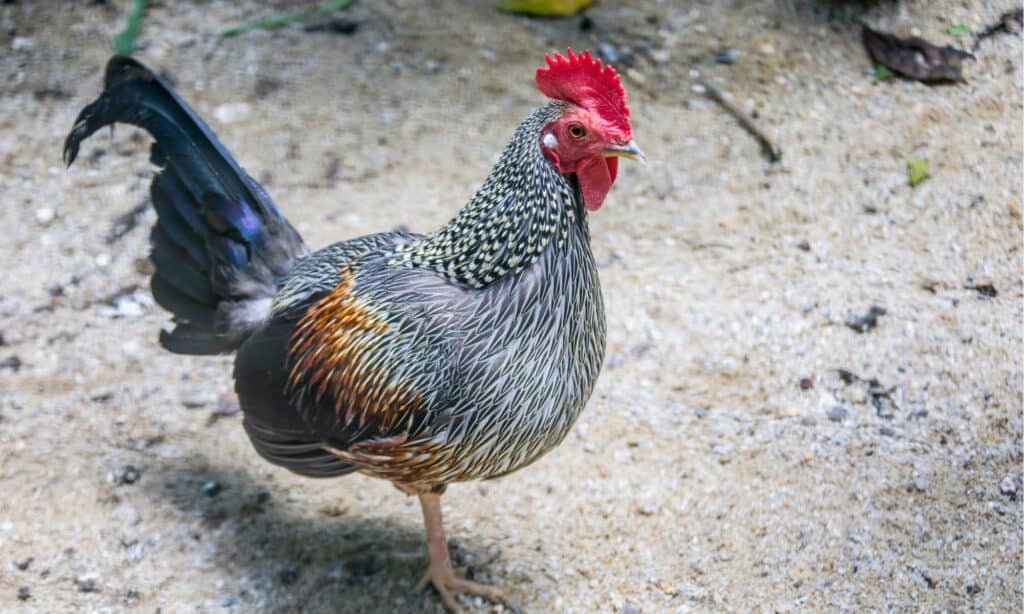
©Danny Ye/Shutterstock.com
Junglefowl vs. Chicken
All species of junglefowl diverged from their common ancestor 4-6 million years ago. The grey and red junglefowl diverged 2.6 million years ago.
The domestic chicken shares 71-79% DNA with the red junglefowl and is therefore considered a subspecies of it. It is believed that the domestic chicken’s yellow skin came from the grey junglefowl. Also, indigenous village chickens showed crossbreeding with the Sri Lankan, grey, and green junglefowl. There’s a hybrid of the red and green junglefowl in Indonesia called the bekisar.
Another difference is in their behavior. Junglefowl is very shy of humans, whereas domestic chickens are tamed. Also, junglefowl can fly for short distances, unlike domestic chickens which are worse at flying.
Behavior
Junglefowl does not migrate but may instead wander from their territories during drought to seek out food. The bird is semi-flightless and can only fly short distances, usually running to a shelter or flying to high perches in trees away from predators. Unlike male red junglefowl, male grey junglefowl does not flap their wings before calling.
Male junglefowl makes a crowing “cock-a-doodle-do” sound, especially to announce their presence to females during the breeding season. Males are territorial. They also have specific calls to warn others of predators in addition to clucking noises.
Both sexes have an aggressive hierarchy sorted by rank, which is where the term “pecking order” comes from.
Diet
The junglefowl diet is omnivorous, a combination of insectivorous or carnivorous and herbivorous. Hence, it eats plant matter, invertebrates, small rodents, reptiles, and amphibians. It does so by foraging and scratching with its clawed feet or digging with its bill, or perching on brains and feeding on hanging plant matter. Green potatoes, nightshade plants, and onions are toxic to junglefowl.
What does jungle fowl eat?
Junglefowl eats cracked corn, soybeans, grasses, grains, seeds, fruits, roots, tubers, leaves, worms, slugs, insects, mice, small lizards, and frogs.
Predators and Threats
Many birds of prey and land-dwelling predators eat junglefowl. Eagles and leopard cats are a couple of examples.
The junglefowl is threatened by crossbreeding with domestic chickens. For example, the bekisar, which is a cross between a domestic chicken and the green junglefowl, is the mascot of the East Java province.
The red junglefowl‘s population is decreasing but listed as Least Concern, as is the grey junglefowl.
The green and Sri Lankan junglefowl populations are both stable and listed as Least Concern.
Reproduction, Babies, and Lifespan
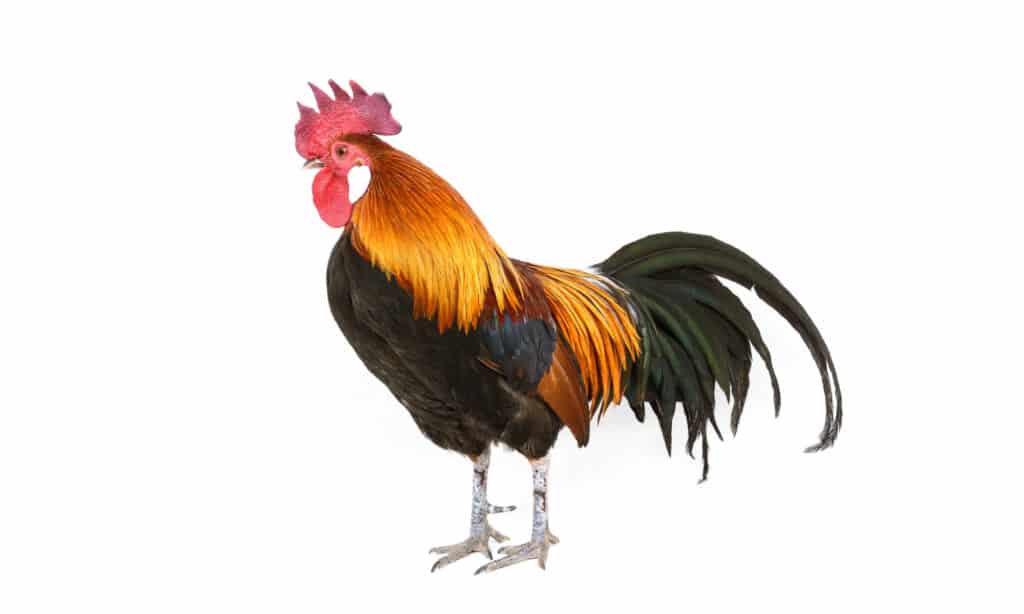
The red junglefowl practices polygyny, which implies that the male will have a group of females (harem) in his flock.
©Prachaya Roekdeethaweesab/Shutterstock.com
The red junglefowl is polygynous, meaning the male will have a harem of females in his flock. The Sri Lankan junglefowl is polygynandrous or polandrous, meaning a female will mate with two or three males, which tend to be siblings, first pairing with the alpha male.
Courtship begins with a male performing “tidbitting,” which is finding food in front of a female and giving it to her. He also makes clucking noises and bobbing motions of his head and neck.
The junglefowl hen makes a nest high off the ground. She and a male mate by sexual reproduction and the hen lays both fertilized and non-fertilized eggs depending on whether she’s mated or not. They typically mate during the dry seasons, which are winter and spring.
During the spring and summer, hens can lay an egg every day. They are creamy to light brown in color, often with a yellow or pink tint and dark splotches, and number 3-9, but 4-5 on average. Incubation is 18-26 days, with the red and Sri Lankan junglefowl taking 20 days and the green junglefowl 21-26 days.
Baby Junglefowl is called a chick. Males do not assist in the raising of chicks. However, the alpha male guards the nest from a nearby perch, while beta males guard the territory from farther away.
The chicks fledge in 4-5 weeks and the hen chases them out at 12 weeks. Being able to fly at 6-7 days after hatching, they can fly on their own at 45-60 days. They reach sexual maturity at 20-24 weeks of age, with the females taking longer than the males. Their lifespan is about 3-14 years in the wild (12-14 on average) and 10-30 years (up to 30) in captivity.
Population
The population numbers of junglefowl are unknown. However, they are generally threatened by crossbreeding with domestic chickens. They may also be threatened by hunting and habitat loss in some areas.
View all 36 animals that start with JJunglefowl FAQs (Frequently Asked Questions)
Does junglefowl migrate?
No, but they may move to new territories in search of food.
How many eggs does junglefowl lay?
Hens lay 3-9 eggs but 4-5 on average.
How fast do junglefowl fly?
It is unknown how fast they can fly because they only fly short distances. However, they can fly up 10-15 feet.
What is junglefowl’s wingspan?
The male’s wingspan is 26-32in long, and the female’s wingspan is 14-25in long.
When does junglefowl leave the nest?
They fledge at 12 weeks.
Is a chicken junglefowl?
Yes. Domestic chickens are considered a subspecies of the red junglefowl and sometimes “junglefowl” is a synonym for chicken, although the former usually refers to the wild counterpart.
What does junglefowl mean?
A wild game bird in the genus Gallus.
Can red junglefowl fly?
Somewhat. They are semi-flightless birds, so instead tend to do what’s called burst flight to get over obstacles or away from predators. Domestic chickens can’t fly at all.
How long do junglefowl live?
Their lifespan is an average of 12-14 years in the wild and up to 30 years in captivity.
Thank you for reading! Have some feedback for us? Contact the AZ Animals editorial team.
Sources
- Wikipedia, Available here: https://en.wikipedia.org/wiki/Junglefowl
- Wikipedia, Available here: https://en.wikipedia.org/wiki/Red_junglefowl
- Wikipedia, Available here: https://en.wikipedia.org/wiki/Sri_Lankan_junglefowl
- Wikipedia, Available here: https://en.wikipedia.org/wiki/Green_junglefowl
- Wikipedia, Available here: https://en.wikipedia.org/wiki/Grey_junglefowl
- Wikipedia, Available here: https://en.wikipedia.org/wiki/Chicken
- What Bird, Available here: https://identify.whatbird.com/obj/1148/behavior/Red_Junglefowl.aspx
- Backyard Chickens, Available here: https://www.backyardchickens.com/threads/red-junglefowl-and-natural-nests.522296/
- Animalia, Available here: https://animalia.bio/red-junglefowl
- Kidadl, Available here: https://kidadl.com/animal-facts/red-junglefowl-facts
- Cemani Farms, Available here: https://cemanifarms.com/red-jungle-fowl/
- Lay Some Eggs, Available here: https://laysomeeggs.com/wildchickens/
- Animal Corner, Available here: https://animalcorner.org/animals/grey-jungle-fowl-birds/
- Research Gate, Available here: https://www.researchgate.net/publication/283444863_The_ontogeny_of_personality_traits_in_the_red_junglefowl_Gallus_gallus
- Animal Diversity Web, Available here: https://animaldiversity.org/accounts/Gallus_gallus/
- Animalia, Available here: https://animalia.bio/grey-junglefowl
- Chickens & More, Available here: https://www.chickensandmore.com/can-chickens-fly/
- What-When-How, Available here: https://what-when-how.com/birds/red-junglefowl-birds/
- The Open Sanctuary Project, Available here: https://opensanctuary.org/article/things-that-are-toxic-to-chickens/
- Omlet, Available here: https://www.omlet.us/guide/chickens/chicken_care/poisonous_plants_and_food/
- Patch To Table, Available here: https://patchtotable.com/toxic-chicken-treats-myths-and-facts-about-what-you-can-feed-your-chickens/

















